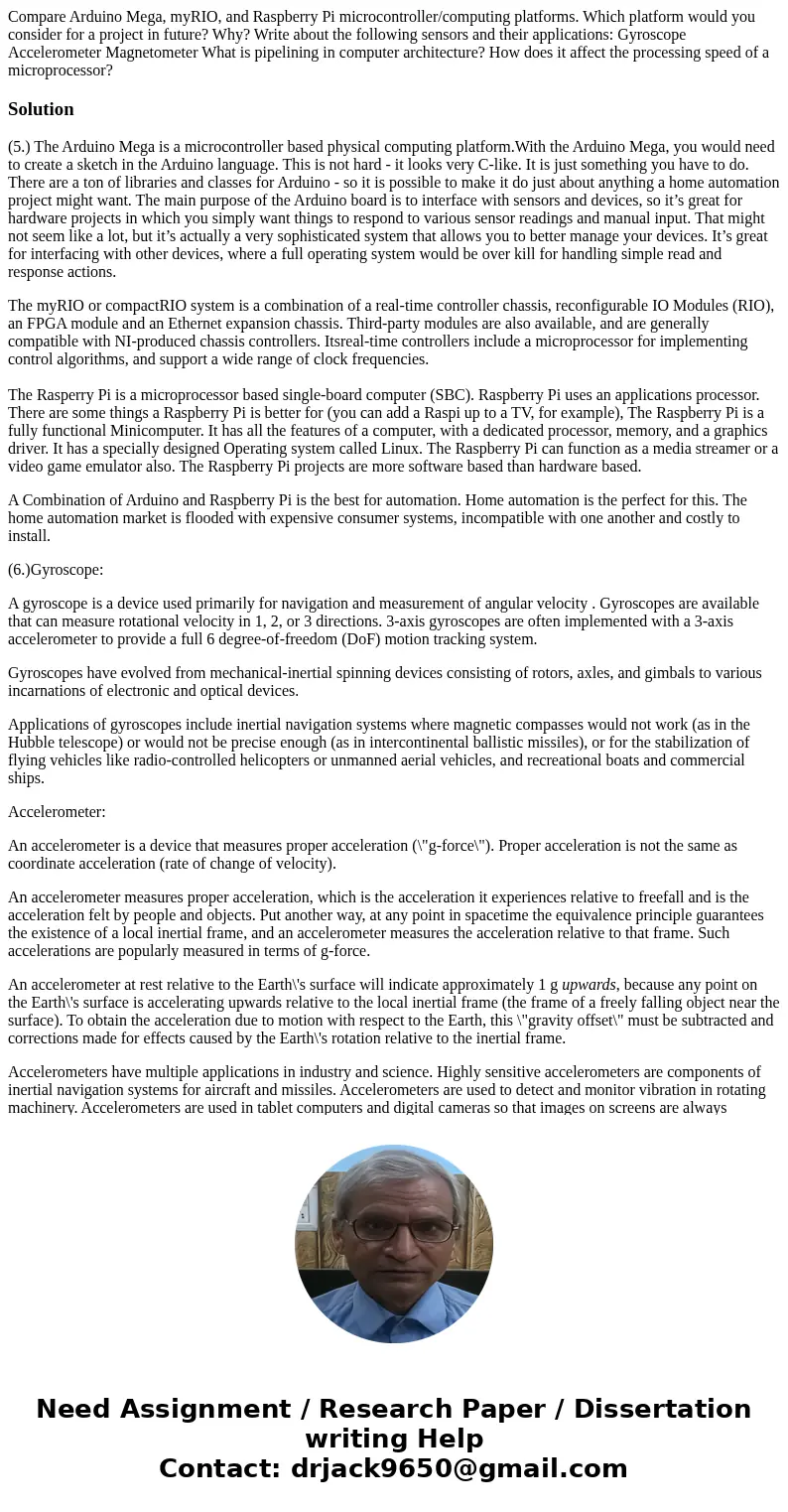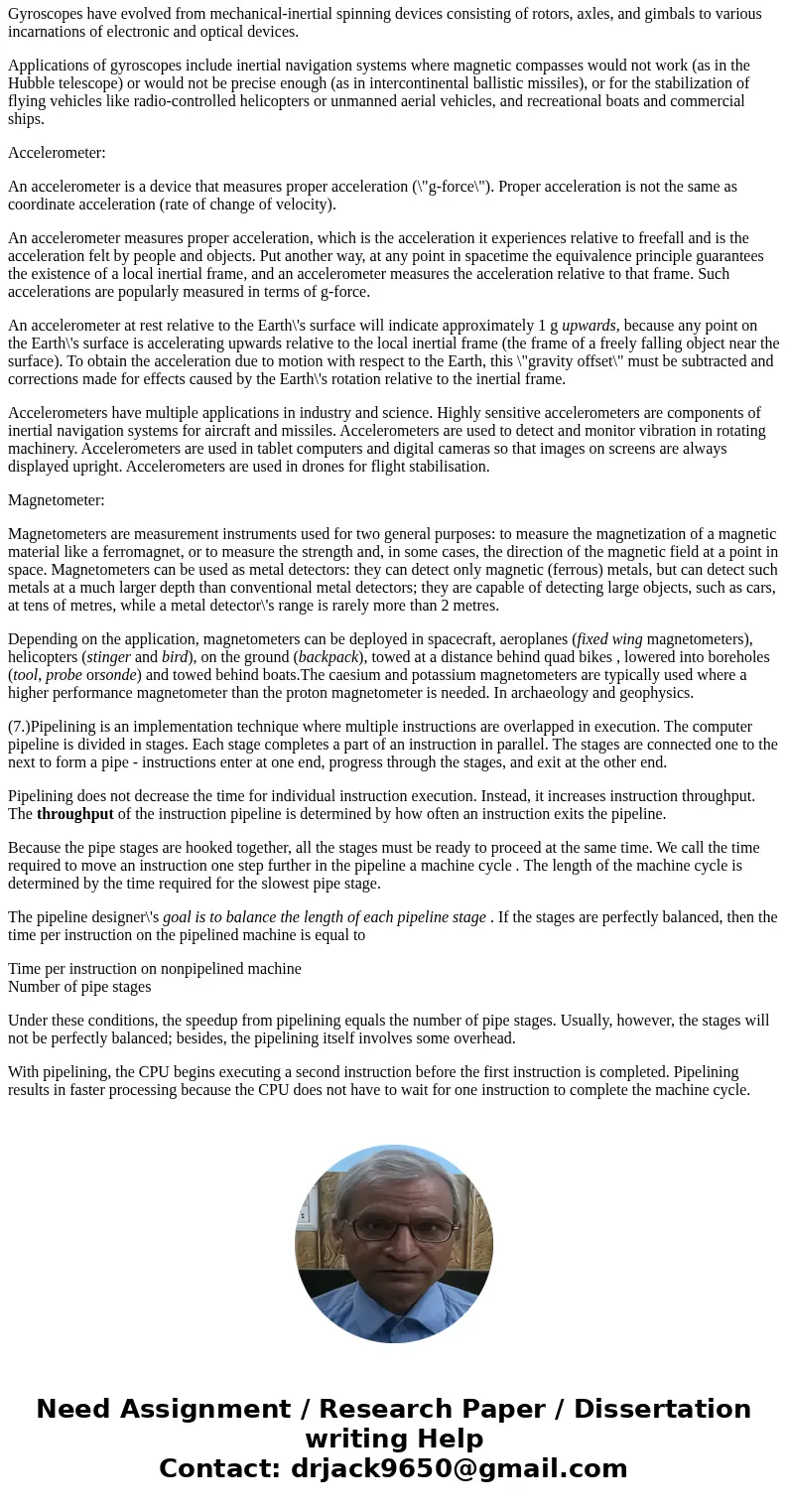Compare Arduino Mega myRIO and Raspberry Pi microcontrollerc
Solution
(5.) The Arduino Mega is a microcontroller based physical computing platform.With the Arduino Mega, you would need to create a sketch in the Arduino language. This is not hard - it looks very C-like. It is just something you have to do. There are a ton of libraries and classes for Arduino - so it is possible to make it do just about anything a home automation project might want. The main purpose of the Arduino board is to interface with sensors and devices, so it’s great for hardware projects in which you simply want things to respond to various sensor readings and manual input. That might not seem like a lot, but it’s actually a very sophisticated system that allows you to better manage your devices. It’s great for interfacing with other devices, where a full operating system would be over kill for handling simple read and response actions.
The myRIO or compactRIO system is a combination of a real-time controller chassis, reconfigurable IO Modules (RIO), an FPGA module and an Ethernet expansion chassis. Third-party modules are also available, and are generally compatible with NI-produced chassis controllers. Itsreal-time controllers include a microprocessor for implementing control algorithms, and support a wide range of clock frequencies.
The Rasperry Pi is a microprocessor based single-board computer (SBC). Raspberry Pi uses an applications processor. There are some things a Raspberry Pi is better for (you can add a Raspi up to a TV, for example), The Raspberry Pi is a fully functional Minicomputer. It has all the features of a computer, with a dedicated processor, memory, and a graphics driver. It has a specially designed Operating system called Linux. The Raspberry Pi can function as a media streamer or a video game emulator also. The Raspberry Pi projects are more software based than hardware based.
A Combination of Arduino and Raspberry Pi is the best for automation. Home automation is the perfect for this. The home automation market is flooded with expensive consumer systems, incompatible with one another and costly to install.
(6.)Gyroscope:
A gyroscope is a device used primarily for navigation and measurement of angular velocity . Gyroscopes are available that can measure rotational velocity in 1, 2, or 3 directions. 3-axis gyroscopes are often implemented with a 3-axis accelerometer to provide a full 6 degree-of-freedom (DoF) motion tracking system.
Gyroscopes have evolved from mechanical-inertial spinning devices consisting of rotors, axles, and gimbals to various incarnations of electronic and optical devices.
Applications of gyroscopes include inertial navigation systems where magnetic compasses would not work (as in the Hubble telescope) or would not be precise enough (as in intercontinental ballistic missiles), or for the stabilization of flying vehicles like radio-controlled helicopters or unmanned aerial vehicles, and recreational boats and commercial ships.
Accelerometer:
An accelerometer is a device that measures proper acceleration (\"g-force\"). Proper acceleration is not the same as coordinate acceleration (rate of change of velocity).
An accelerometer measures proper acceleration, which is the acceleration it experiences relative to freefall and is the acceleration felt by people and objects. Put another way, at any point in spacetime the equivalence principle guarantees the existence of a local inertial frame, and an accelerometer measures the acceleration relative to that frame. Such accelerations are popularly measured in terms of g-force.
An accelerometer at rest relative to the Earth\'s surface will indicate approximately 1 g upwards, because any point on the Earth\'s surface is accelerating upwards relative to the local inertial frame (the frame of a freely falling object near the surface). To obtain the acceleration due to motion with respect to the Earth, this \"gravity offset\" must be subtracted and corrections made for effects caused by the Earth\'s rotation relative to the inertial frame.
Accelerometers have multiple applications in industry and science. Highly sensitive accelerometers are components of inertial navigation systems for aircraft and missiles. Accelerometers are used to detect and monitor vibration in rotating machinery. Accelerometers are used in tablet computers and digital cameras so that images on screens are always displayed upright. Accelerometers are used in drones for flight stabilisation.
Magnetometer:
Magnetometers are measurement instruments used for two general purposes: to measure the magnetization of a magnetic material like a ferromagnet, or to measure the strength and, in some cases, the direction of the magnetic field at a point in space. Magnetometers can be used as metal detectors: they can detect only magnetic (ferrous) metals, but can detect such metals at a much larger depth than conventional metal detectors; they are capable of detecting large objects, such as cars, at tens of metres, while a metal detector\'s range is rarely more than 2 metres.
Depending on the application, magnetometers can be deployed in spacecraft, aeroplanes (fixed wing magnetometers), helicopters (stinger and bird), on the ground (backpack), towed at a distance behind quad bikes , lowered into boreholes (tool, probe orsonde) and towed behind boats.The caesium and potassium magnetometers are typically used where a higher performance magnetometer than the proton magnetometer is needed. In archaeology and geophysics.
(7.)Pipelining is an implementation technique where multiple instructions are overlapped in execution. The computer pipeline is divided in stages. Each stage completes a part of an instruction in parallel. The stages are connected one to the next to form a pipe - instructions enter at one end, progress through the stages, and exit at the other end.
Pipelining does not decrease the time for individual instruction execution. Instead, it increases instruction throughput. The throughput of the instruction pipeline is determined by how often an instruction exits the pipeline.
Because the pipe stages are hooked together, all the stages must be ready to proceed at the same time. We call the time required to move an instruction one step further in the pipeline a machine cycle . The length of the machine cycle is determined by the time required for the slowest pipe stage.
The pipeline designer\'s goal is to balance the length of each pipeline stage . If the stages are perfectly balanced, then the time per instruction on the pipelined machine is equal to
Time per instruction on nonpipelined machine
Number of pipe stages
Under these conditions, the speedup from pipelining equals the number of pipe stages. Usually, however, the stages will not be perfectly balanced; besides, the pipelining itself involves some overhead.
With pipelining, the CPU begins executing a second instruction before the first instruction is completed. Pipelining results in faster processing because the CPU does not have to wait for one instruction to complete the machine cycle.


 Homework Sourse
Homework Sourse